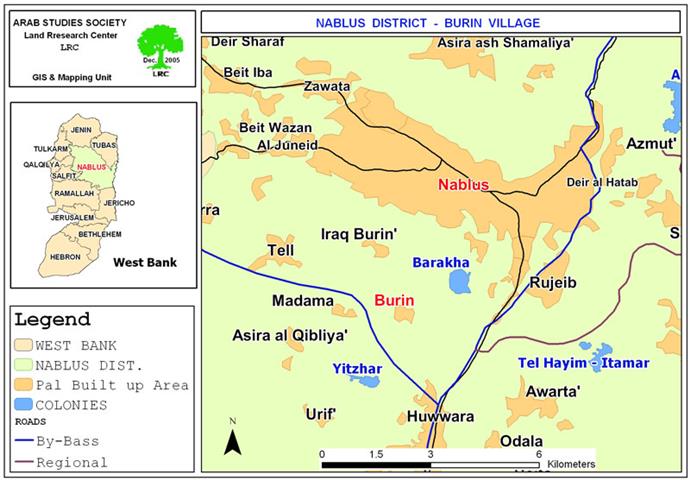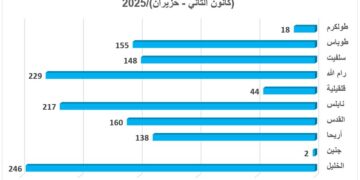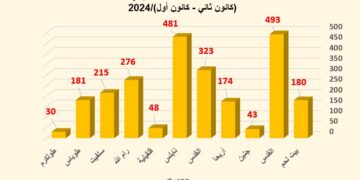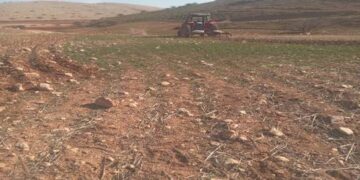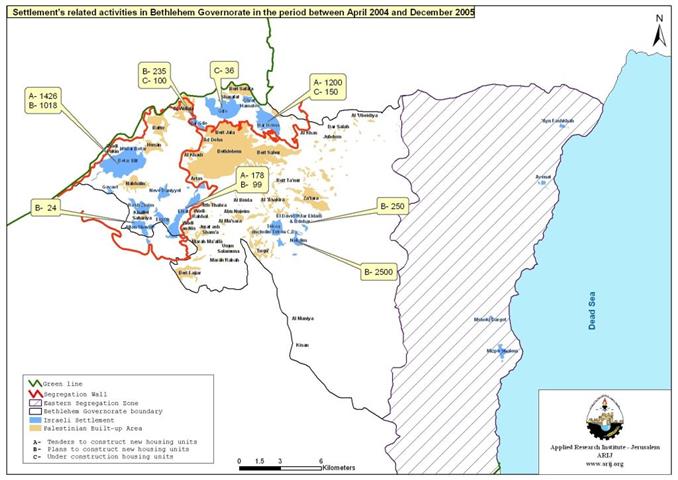Israeli settlers from Bracha and Yitizhar, Nablus region, cut hundreds of olive trees belonging to Palestinians from the village of Burin, Nablus governorate on December 15 and 25.
Location, population and area
The village of Burin is located 10 km to the south of Nablus city. Its population mounts to 3000 inhabitants, mostly working in agriculture. Its total area is estimated at 10415 dunum, of which 188 dunum are built up area. Burin's land meets with the southern land of Nublus city. See Map 1

Map 1: Location of Burin village and surrounding settlements)
The latest colonial attack
In two separate incidents, settlers from the settlements of Bracha and Yizhar attacked the olive orchards as followed:
The first attack took place on December 15th, 2005 at the hands of Bracha settlers. According to local farmers at Burin village, the target land was plowed by its Palestinian owners a day before, December 14th, and the attackers came the second day, December 15th , sawing down the total of 177 fruitful olive trees at the location of Bab As Sunieh and Khallet Abdullah. See Photo 1

(photo 1: family members from Burin are inspecting the destroyed trees (Photo courtesy of LRC))
Below is a list of the names of victims and number of cut trees:
|
Number |
Name |
No. of olive sawed trees |
|
1 |
Taher Mahmud Abed Najar |
35 |
|
2 |
Qasem Daood Ibrahim |
53 |
|
3 |
Hasna isa Najar |
18 |
|
4 |
Mahmud Raja Eid |
35 |
|
5 |
Waleed Jibril Eid |
35 |
|
6 |
Fahmiya Hasan Eid |
1 |
|
|
Total |
177 |
The second attack was carried out on December 25th, when a group of settlers from Yizhar sawed down 90 olive trees of old Roman species in the location of Ein Al Jineina and owned by the following farmers:
|
Number |
Name |
No. of olive sawed trees |
|
1 |
Abdullah Sharif Zibin |
50 |
|
2 |
'Arif Kamel Ayuub |
40 |
|
|
Total |
90 |

( photo 2: An Israeli soldier inspecting the sawed down n trees
Photo courtesy of( LRC)
Introduction to Bracha settlement
The settlement was established in 1982 by Gush Amunim settlement group at the top of the Mount Girizim at the southern edge of Nablus city. It was built over lands confiscated from the village of Burin. More than 1062 dunums of private lands were seized from Burin for this purpose.
Once started, the settlement had 55 families. In 1990, it had the population of 95 settlers and by the end of 2003, this number increased to 880 (Source- Foundation for Middle East Peace). The settlement has been designed to accommodate not less than 6000 settlers in the long run.
Introduction to Yizhar settlement
It was founded in 1983 over lands seized from the villages of Burin, Urif, Madama and Asira Al Qibliya. The total of 1800 dunums, located in basins 8 and 4 of Madama and basin number 1 of Asira Al Qibliya as well as basin number 3 of Burin.
Once founded the settlement had the population of 65 settlers. By the end of 2003, this number reached 440 ( Source- Foundation For Middle East Peace).
Previous harassments:
The village of Burin is located between the jaws of the two settlements: Bracha, from north and east; Yizhar , from south and west. On many occasions, settlers intercepted farmers heading to their fields and prevented them from tending their lands and picking yields. There are about 700 dunums of lands cultivated with olive trees and cereals located in the vicinity of Bracha settlement in addition to another 500 dunums located near Yizhar settlement. Farmers commuting to these lands have become under successive physical attacks and fire shootings at the hands of Israeli settlers living in the area. See Photo 3

(photo 3: Farmers from Burin in their damaged orchard Photo courtesy of LRC)
Mofatz and Halotz informed
As part of the evaluation process of daily situations in ' Shomron Brigade', data has been given to the Israeli Minister of ' defense' Shaul Mofaz and his army chief of staff Dan Halotz on the cutting of one thousand olive trees at the hands of settlers.
In their field reports to Mofaz and Halotz, the brigades' officers said that six incidents have taken place in this regard, the latest of which was at the beginning of this week. According to the reporting officers, settlers sneaked at nights, taking advantage of heavy rain and bitter cold , and sawed hundreds of olive trees.
The officers claimed that the army had no intelligence information reports beforehand supposed to be provided by the Shabak ( Internal Security Service) or by the police.
Prepared by
The Land Research Center
LRC


